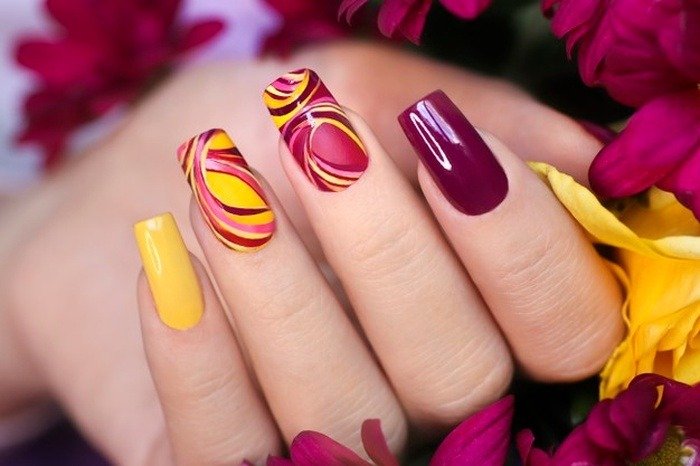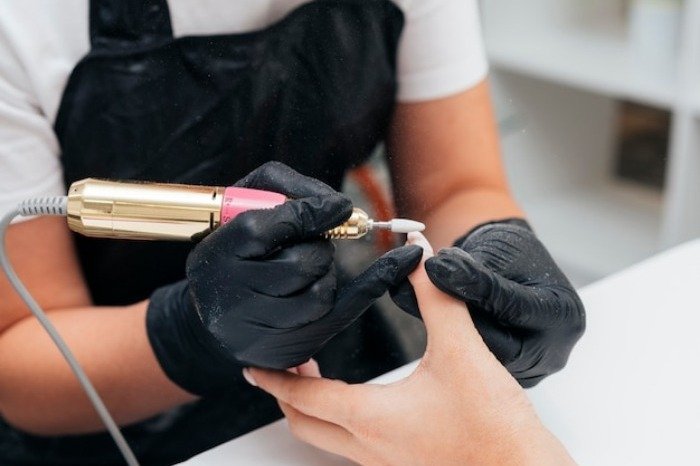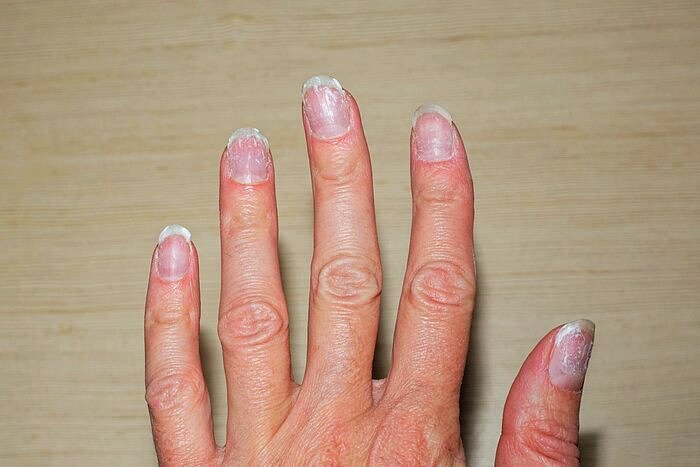Nail coverWhat is it?
There are various methods to beautify nails. Nail beauty and care are very important. One of today’s popular methods is nail covering or laminating, which not only beautifies nails but also strengthens them. Nail covering is similar to nail extensions, except that no tips are used, and the materials are applied directly as a thin layer on the natural nail. Therefore, this method is very suitable for those who dislike thick nails and prefer a more natural look.
Who is suitable for nail covers?
Nails are made of protein layers called keratin, which grow at the base of the nail under the cuticle. Healthy nails are smooth and even with natural grooves and a uniform color without spots or discoloration. Sometimes, due to damage or impact, nails can crack, become uneven, or develop spots. If your nail plates are not aesthetically pleasing and have irregularities, you can use nail covering to enhance the beauty of your fingers.

In addition, those who are tired of nail extensions and their side effects, or whose nails have become thin and brittle after removing materials, will find using a nail cover to strengthen and fortify their nails to be a great option. Additionally, in the fashion world.SelMagzSome individuals are sensitive to the odors of the liquids used in nail extensions and other methods. They can use laminates or nail covers instead.
Steps for covering nails
The nail covering process includes the following steps:
Required tools:
- Cleaner or buffer
- Required tools (scissors, nail clippers, cutter, cuticle pusher)
- Special powder
- Primer (adhesive)
- Manicure polish
- Anti-fungal solution
- Oil
Steps for applying nail cover
- Before starting, clean the entire surface of the nails from any dirt using a manicure method to create a hygienic and suitable condition for the nail cover.
- For the manicure, all dead skin and excess flesh around the nail should be carefully removed without causing damage to the surrounding area.
- Then, lightly scratch the surface of the nails before filing. Do not file too much, as it can lead to fungal issues. During.FilingTry not to remove any of the edges while filing so they remain on the nail.
- At this stage, use a special pad to apply the cleaner to the nails to remove any oils.
- Then apply the anti-fungal solution directly onto the cuticles and nail plates.
- After the anti-fungal solution has dried, use a special brush to apply primer on the nail plate. Be careful not to let the primer touch the cuticle.
- Next, apply the materials one by one onto the nails and place the special mold onto the nails, pressing it well so that the cover sticks to the primer.
- After applying the cover, shape the nails beautifully using a file.
Gel can also be used for nail covering. This method is very suitable for those who have beautiful and well-shaped nails. To do this method, the liquid and acrylic powder are applied to the nails, then fingers need to be placed in a UV device for 2 minutes to dry the gel. After that, file the nails.
How to cover nails with liquid powder
Performing manicure steps:
- Lightly scratching the surface of the nails using a file.
- Applying cleaner with a special pad on the nails to remove oil.
- Applying anti-fungal solution on the cuticle and nail plate.
- Applying primer on the nails after the anti-fungal solution has dried (be careful not to put primer on the cuticle).
- Dip the brush into the liquid, and after dipping into acrylic powder, quickly apply the material onto the nails.
- Refiling and applying cleaner on the nails.
- Applying top shine on the nails and placing the nails in the UV device for 2 minutes to dry the materials.
- After performing the manicure and using the anti-fungal solution, apply primer on the nails.

How to do gel nails
- Carefully apply base coat number one on the nail plate and place the hand into the UV device to dry the polish.
- Then apply gel polish on the nails and again place the hand into the device to dry the polish.
- After drying the gel polish, you can use other colors for design, but be careful not to make the nails too thick.
- In this step, after applying the top coat to protect the polish and shine, place your hand inside the device.
- In the final step, use top shine on the nails and again place your hands in the device to remove the stickiness of the materials by applying cleaner on the nails.
Methods for removing and taking off the nail cover
Required tools for removing nail cover:
- Acetone and gel polish remover
- Cotton balls
- Nail file or buffer
- Aluminum foil
Using the following methods makes it easy to remove the cover from the nails.
- Use a file on the surface of the nail to reduce the thickness of the cover, making it easier to remove. Be careful not to file too much as it might damage the natural nail surface.
- Soak cotton balls with 100% acetone and place them on the nails. Be careful not to use too much acetone as it may cause discoloration of the nails.
- Cut aluminum pieces into equal sizes and wrap them around the fingers while the cotton is on the nails to keep the fingertips inside the foil for 15 minutes. During this time, the cover will soften and begin to peel off. Check each nail to see if the covers have softened; if they haven’t detached, rewrap the foil around your fingers.
- After unwrapping the foils, gently scrape off the materials from the nails using a special scraper (manicure stick), and then file the nails to remove any remaining materials.
- Clean the nails.
Who should avoid nail extensions and covers?
Individuals with infectious or fungal diseases should not use extension or laminating methods as these methods can hinder the visibility of disease progression.
Additionally, those with a weak immune system and prone to infections should avoid nail extensions or covers as it may expedite their health issues.
How to repair nail covers
Repairing nail covers is similar to repairing extensions because these methods are not permanent and need repairs at least twice a month. As nails grow and expose the cover, there is a risk of the cover detaching.
Additionally, trauma or excessive washing can cause the cover to break or detach. Repairing nails helps restore their beauty. This method is similar to nail extension repair, except that during nail cover repair, no new tips or artificial nails are applied. Only the materials are replaced after removing the old ones, and the area around the nails is tidied up, repeating the initial covering steps.
The shaping of the nail cover is done according to the client’s preference. In the final step, oil is applied to the cover.
Side effects of nail covers
Nail covers, like any other method, have side effects because any barrier to oxygen reaching the nails is harmful, which can include nail deformation, fungal infections, discoloration, or bruising. It may also happen that due to the materials used, the nails turn green or become disfigured. However, after removing the cover, strengthening treatments can be done.fornails using home remedies.

Answers to common questions about nail covers
* What is the main difference between nail extensions and nail covers?
With nail extensions, you can easily set the length and thickness to your desired level. But nail covers, since they are applied over the person’s natural nail, have less flexibility and only allow for slight adjustments in length and shape.
* What causes pain in the nails after covering?
** The main cause of nail pain after covering is related to filing. A bit of pain after the first covering is normal for 2-3 days. If you experience pain again in subsequent sessions, be sure to inform your nail technician to reduce pressure while filing.
* Are the materials used for nail covers or laminates the same as those used for nail extensions?
Yes, the same powder is used in both cases.
* Does nail covering help make nails longer?
Yes, there is a possibility of slight lengthening when laminating due to its shaping property.
* Is it allowed to perform ablution with nail covers?
Regarding your common questions, users are advised to only consult their religious authority on this matter, as opinions about this issue may vary and no general answer can be provided.
* Does nail covering thin the nails?
Yes, if the laminating process is done by unqualified individuals, there is a risk of thinning orbreaking nails.It can happen.
* Does nail covering require repair as well?
Yes, due to the natural growth of nails, nail covers need repairs just like extensions, and the best time for repairs is every two weeks.
* How much does it cost to laminate nails?
** The cost of nail lamination depends on factors such as the materials used and the technician.







